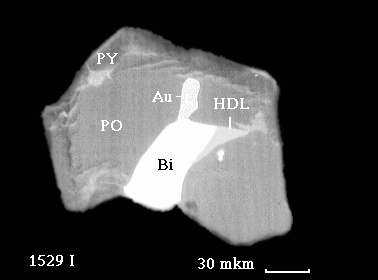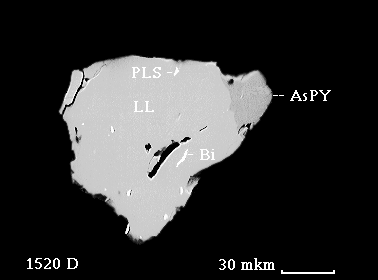Gold in Karelia greenstone belts
Introduction
|
Geological map of Russian Karelia (full size image is available; click on the full size image will enlarge it more)
|
|
 |
 |
Belts with two types of section stand out among Upper Archean (Lopian) greenstone belts of Karelia: Kostomukshky (western) and Hauttavarsky (eastern). As a first approximation the both types of section have a trinomial (three-part) structure:
A considerable thickness of the upper part of section formed by greywackes and leptites followed by inevitable presence of ferruginous quartzites is a special feature of Kostomukshky type of section. The upper part of Hauttavarsky type of section is reduced and ferruginous quartzites are absent. But the proportion of the middle volcanogenous-sedimentary part is considerably increased. The presence of pyrrhotite (PO) and chalcopyrite (CP) mineralization (so-called fahlbands) is characteristic for the middle part.
The realization of researches pursued the following purposes:
|
Minerals. Back Scattered Electron Microscope Images
Clicking on images provides the higher resolution ones
|
||||
|
1
|
Disulphidization of PO-CP mineralisation: pyrrhotite (PO) in marcasite (MRC) and pyrite borders.
|
|
2
|
Interaction between disulphidizated PO-CP ores (PO <-- PY) and Au-Bi mineral paragenesis: Au, Bi – native gold and bismuth, HDL – hedleyite (Bi7Te3). Au-Bi paragenesis is clearly more recent.
|
|
3
|
Interaction between sulphoarsenides and arsenides of iron and Au-Bi mineral paragenesis: LL-lollingite (FeAs2), AsPY – arsenopyrite (FeAsS), Bi – native bismuth, PLS - pilsenite (Bi4Te3). Bi and Te fill the hollows and pores in arsenic minerals (See Full Image).
|
|
4
|
Euhedral arsenopyrite inclusions in native bismuth. Hollows and pores in arsenopyrite are filled by native bismuth (See Full Image).
|
|
5
|
Au-Bi mineral paragenesis: Au, Au 1, EL- phases (Au,Ag), (See Full Image), Bi – native bismuth, HDL – hedleyite (Bi7Te3), JS-b – Joseite-b (Bi4Te2S).
Hauttavarsky Upper Archean type of section. Parandovsky district. (See the map). |
|
6
|
Au-Bi mineral paragenesis: Au, EL-phases (Au, Ag), (See Full Image), Bi – native bismuth.
Kostomukshky Upper Archean type of section. Bolsheozersky district. (See the map).
|
|
7
|
Au-Bi mineral paragenesis: Au, EL- phases (Au,Ag), (See Full Image), Bi – native bismuth, JS-b – Joseite-b (Bi4Te2S), PO - pyrrhotite (FeS).
|
|
8
|
Intergrowth of native gold and bismuth.
|
Discussion
The obtained data allows to the following conclusions:
- Native gold (from electrum to high-fineness gold) is present in both Kostomukshky and Hauttavarsky Archean greenstone belts (zones) of Karelia. The gold is paragenetically bound up with bismuth and bismuth-tellurium minerals: native bismuth, hedleyite, joseite-b, pilsenite. These and other Bi-Te minerals are inherent to gold mineralization not only in Karelia but in ore manifestations and working mines of Finland as well. This is shown by A. Luukkonen [2] in his studies. A large extent of Au, Bi, Te correlation is shown by P.Nurmi and his colleagues [1] in extended geochemical studies not only for Archean greenstone belts of Finland but for more recent Proterozoic deposits.
- Steadiness of Au, Bi, Te paragenesis does not depend upon the type of Archean section in which it is occur. An important point is that gold is revealed without regard to presence of sulphide minerals of PO-CP ores. In the cases when mineral paragenesis with gold is associated with sulphides we can distinctly see imposition of Au, Bi, Te on sulphides (photo 2). The following steady sequence lines on: formation of sulphides -> their transformation by ensuing processes ( disulphidization, photo 1) -> Au-Bi-Te mineralization (photo 2,3,5,7,8).
- Arsenide and sulphoarsenide mineralization can spatially coincide with Au-Te-Bi but be paragenetically divorced with gold: gold occurs in the same invariant paragenesis in the absence of arsenides as well. The gold is evidently independent to arsenide and sulphoarsenide mineralisation when one's present along with gold (photo3 and 4).
- We have information about gold mineralization only. Therefore it was difficult to determine genetic relation between concrete regional gold-forming process and duration of this process, but our preliminary suppositions calling for further refinements do not seem anticipatory. The fact that gold in steady Bi-Te paragenesis is manifested in deposits of broad age interval including Early Proterozoic [1, 2] demonstrate that the events causing regional thermal process played a role of thermal "furnace" or "stove". This process was causing similar redistribution of chemical elements depending on character of permeability and composition of host deposits of different age and also dynamics of heat transference. Probably, the age of such process can be related to one of the stages of formation of Svecofennian structure of the region.
Indirectly it is confirmed by the fact that Bi-Te paragenesis along with noble metals is cosmopolitan: Bi minerals are associated either with PGE minerals of hydrothermal (!) genesis in Outokumpu Ophiolites and with Au-Pd mineralization in black shale deposits of Early Proterozoic Zaonega formation. (See the corresponding sections of this site).
References
- Nurmi, P.A., Lestinen, P. and Niskavaara, H. 1991. Geochemical characteristics of mesothermal gold deposits in Fennoscandian Shield, and a comparison with selected Canadian and Australian deposits. Geological Survey of Finland, Bulletin 351.
- Luukkonen, A. 1994. Main geological features, metallogeny and hydrothermal alteration phenomena of certain gold-tin-tungsen prospects in southen Finland.Geological Survey of Finland, Bulletin 377.








